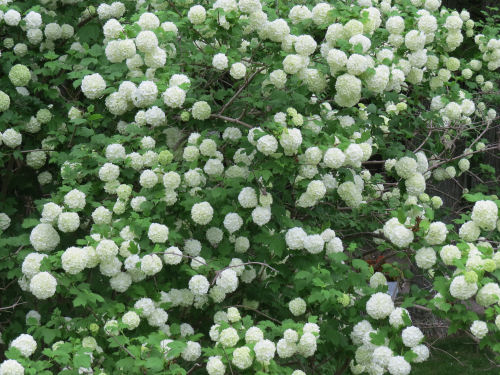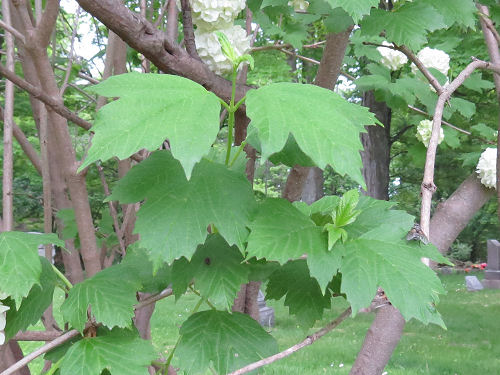I briefly mentioned snowball viburnum the other day. I don't have one of those now, but we did at the house where I grew up. I like this shrub a lot. This one is in the cemetery.

You can see why it's usually just called snowball bush!

When I was a child we usually took flowers to the cemetery on Memorial Day to put on my grandparents' graves. I remember huge bouquets of iris, spirea, snowball bush, lily of the valley, lilacs, and peonies.
The balls range from light green to pure white, with clusters of five-petaled flowers.

As an ornamental planting it is centuries old, although I couldn't find exactly when it was introduced. It probably was developed in Holland.
They are actually a cultivar of the same plant called highbush cranberry that I've mentioned several times. And here are the leaves, very typically viburnum.

The cultivar is Viburnum opulus 'Roseum', (or 'Sterilis' or 'Snowball'- they are all the same). The deal is that all of these flowers you see are sterile. If you look closely (the picture above is more clear) you can see there are no stamens or pistil in the middle of those blooms. Lots of show, but none of the working parts!
Here is a typical natural viburnum flower head. The outer flowers are sterile to attract pollinators, but those tiny inner ones (not open yet in this picture) do the reproductive work.

Some Dutch plant tinkerer figured out how to make the plant grow only sterile blossoms, and when they take up all the space the result is the globular flower head (corymb).
 | See While Viburnums Are the Topic... |
| if you like this blog, click the +1 | |
2 comments:
This is fascinating. I'd nver heards of a snowball bush before. The flowers do look like hydrangeas. I had one at my last garden. My mother bought a blue one for me, but it turned pink because of the clay based soil in my garden.
They are pretty.
Post a Comment